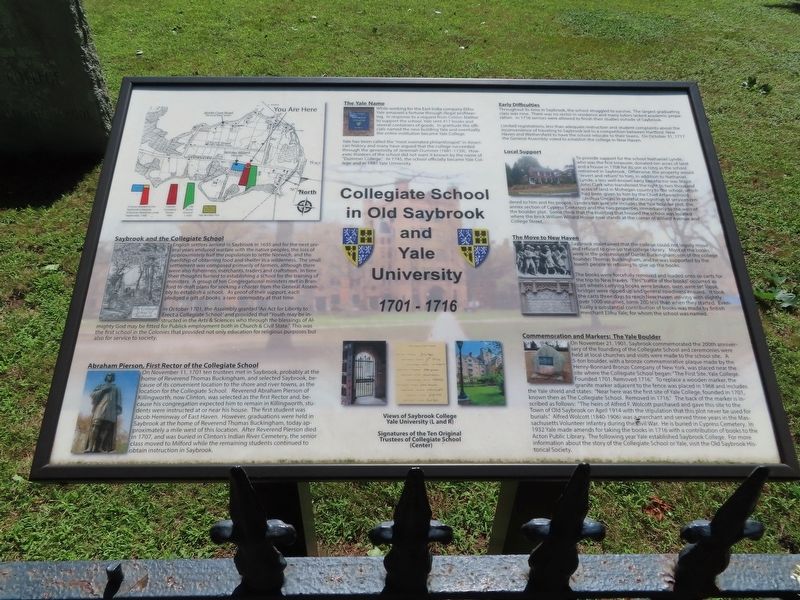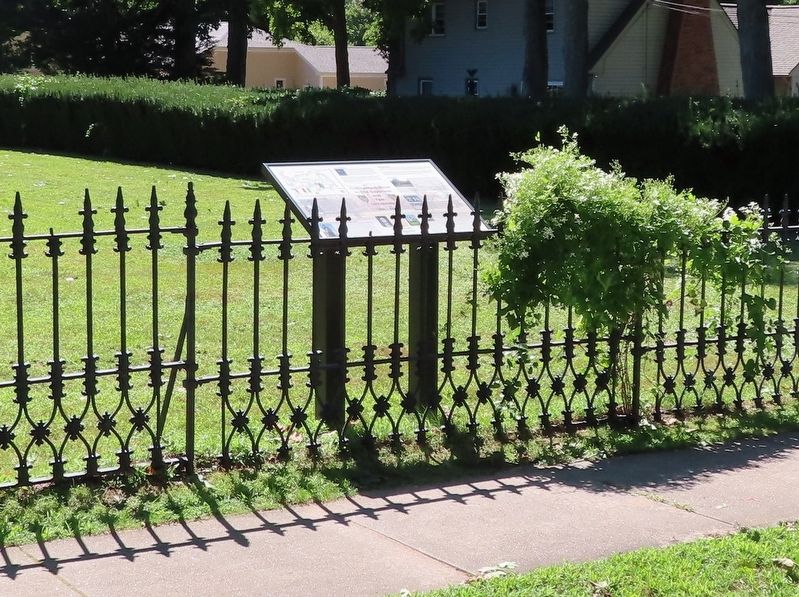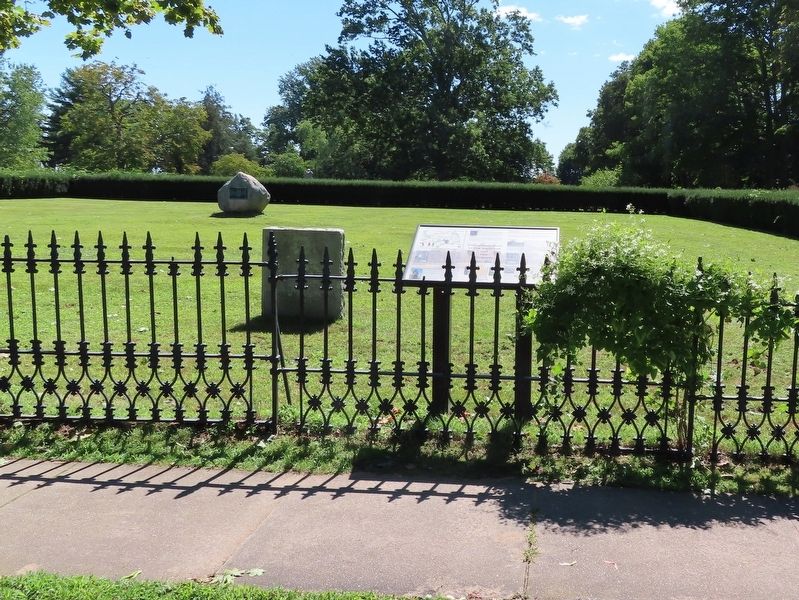Old Saybrook Center in Middlesex County, Connecticut — The American Northeast (New England)
Collegiate School in Old Saybrook and Yale University
1701 - 1716
Inscription.
Saybrook and the Collegiate School
English settlers arrived in Saybrook in 1635 and for the next several years endured warfare with the native peoples, the loss of approximately half the population to settle Norwich, and the hardship of obtaining food and shelter in a wilderness. The small settlement was composed primarily of farmers, although there were also fishermen, merchants, traders and craftsmen. In time their thoughts turned to establishing a school for the training of ministers. A group of ten Congregational ministers met in Branford to draft plans for seeking a charter from the General Assembly to establish a school. As proof of their support, each pledged a gift of books, a rare commodity at that time.
In October 1701, the Assembly granted "An Act for Liberty to Erect a Collegiate School" and provided that "Youth may be instructed in the Arts & Sciences who through the blessings of Almighty God may be fitted for Publick employment both in Church & Civil State." This was the first school in the Colonies that provided not only education for religious purposes but also for service to society.
Abraham Pierson, First Rector of the Collegiate School
On November 11, 1701 ten trustees met in Saybrook, probably at the home of Reverend Thomas Buckingham, and selected Saybrook, because of its convenient location to the shore and river towns, as the location for the Collegiate School. Reverend Abraham Pierson of Killingworth, now Clinton, was selected as the first Rector and, because his congregation expected him to remain in Killingworth, students were instructed at or near his house. The first student was Jacob Heminway of East Haven. However, graduations were held in Saybrook at the home of Reverend Thomas Buckingham, today approximately a mile west of this location. After Reverend Pierson died in 1707, and was buried in Clinton's Indian River Cemetery, the senior class moved to Milford while the remaining students continued to obtain instruction in Saybrook.
The Yale Name
While working for the East India company Elihu Yale amassed a fortune through illegal profiteering. In response to a request from Cotton Mather to support the school, Yale sent 417 books and several containers of goods. In gratitude the officials named the new building Yale and eventually the entire institution became Yale College.
Yale has been called the "most overrated philanthropist" in American history and many have argued that the college succeeded through the generosity of Jeremiah Dummer (1681-1739). However, trustees of the school did not want it known by the name of "Dummer College." In 1745, the school officially became Yale College and in 1887 Yale University.
Early Difficulties
Throughout its time in Saybrook, the school struggled to survive. The largest graduating class was nine. There was no rector in residence and many tutors lacked academic preparation. In 1716 seniors were allowed to finish their studies outside of Saybrook. Limited registrations, less than adequate instruction and student complaints about the inconvenience of traveling to Saybrook led to a competition between Hartford, New Haven and Wethersfield to have the school relocate to their towns. On October 31, 1717 the General Assembly voted to establish the college in New Haven.
Local Support
To provide support for the school Nathaniel Lynde, who was the first treasurer, donated ten acres of land and a house in 1708 for its use as long as the school remained in Saybrook. Otherwise, the property would "revert and return" to him. In addition to Nathaniel Lynde, a less well-known early benefactor was Major John Clark who transferred the right to two thousand acres of land in Mohegan country to the school, which William Willard House, Saybrook Point had been given to him by the Chief Attawanhood (Joshua Uncas) in grateful recognition of services rendered to him and his people. Lynde's ten acre site includes the Yale boulder plot, the annex section of Cypress Cemetery and the two properties immediately to the west of the boulder plot. Some think that the building that housed the school was located where the brick William Willard House now stands at the corner of Willard Avenue and College Street.
The Move to New Haven
Saybrook maintained that the college could not legally move and refused to give up the college library. Most of the books were in the possession of Daniel Buckingham, son of the college founder Thomas Buckingham, and he was supported by the town's people in refusing to give up the books.
The books were forcefully removed and loaded onto ox carts for the trip to New Haven. This "battle of the books" occurred as cart wheels carrying books were broken, oxen were set loose, bridges were ripped up and general rowdiness ensued. It took the carts three days to reach New Haven arriving with slightly over 1000 volumes, some 260 less than when they started. Eventually a substantial contribution of books was made by British merchant Elihu Yale, for whom the school was named.
Commemoration and Markers: The Yale Boulder
On November 21, 1901, Saybrook commemorated the 200th anniversary of the founding of the Collegiate School and ceremonies were held at local churches and visits were made to the school site. A 5-ton boulder, with a bronze commemorative plaque made by the Henry-Bonnard Bronze Company of New York, was placed near the site where the Collegiate School began: "The First Site. Yale College. Founded 1701. Removed 1716." To replace a wooden marker, the granite marker adjacent to the fence was placed in 1968 and includes the Yale shield and states: "Near here was the first site of Yale College, founded in 1701, known then as The Collegiate School. Removed in 1716." The back of the marker is inscribed as follows: "The heirs of Alfred F. Wolcott purchased and gave this site to the Town of Old Saybrook on April 1914 with the stipulation that this plot never be used for burials." Alfred Wolcott (1840-1906) was a merchant and served three years in the Massachusetts Volunteer Infantry during the Civil War. He is buried in Cypress Cemetery. In 1932 Yale made amends for taking the books in 1716 with a contribution of books to the Acton Public Library. The following year Yale established Saybrook College. For more information about the story of the Collegiate School or Yale, visit the Old Saybrook Historical Society.
Topics. This historical marker is listed in this topic list: Education. A significant historical month for this entry is April 1914.
Location. 41° 17.027′ N, 72° 21.34′ W. Marker is in Old Saybrook, Connecticut, in Middlesex County. It is in Old Saybrook Center. Marker is on College Street (Connecticut Route 154) east of Ward Place, on the right when traveling east. Located next to Cypress Cemetery. Touch for map. Marker is in this post office area: Old Saybrook CT 06475, United States of America. Touch for directions.
Other nearby markers. At least 8 other markers are within walking distance of this marker. Yale College Site (here, next to this marker); First Site of Yale College (a few steps from this marker); Cypress Cemetery (within shouting distance of this marker); Lady Alice Fenwick (within shouting distance of this marker); Say Brooke Fort (about 700 feet away, measured in a direct line); Lion Gardiner (approx. 0.2 miles away); Battlefields of the Pequot War (approx. 0.2 miles away); The Fenwicks (approx. 0.2 miles away). Touch for a list and map of all markers in Old Saybrook.
Also see . . .
1. Yale University. (Submitted on September 17, 2021, by Michael Herrick of Southbury, Connecticut.)
2. Old Saybrook Historical Society. (Submitted on September 17, 2021, by Michael Herrick of Southbury, Connecticut.)
3. Yale University (Wikipedia). (Submitted on September 17, 2021, by Michael Herrick of Southbury, Connecticut.)
Credits. This page was last revised on February 10, 2023. It was originally submitted on September 17, 2021, by Michael Herrick of Southbury, Connecticut. This page has been viewed 552 times since then and 95 times this year. Photos: 1, 2, 3. submitted on September 17, 2021, by Michael Herrick of Southbury, Connecticut.


